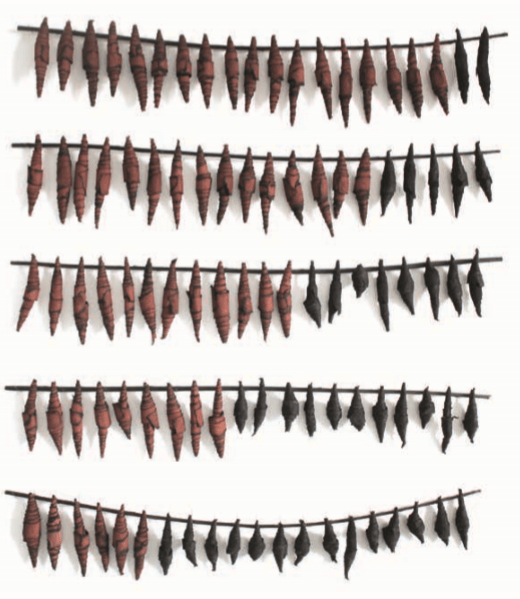
Ann Goddard
SOME ARTISTS LOOK LIKE the work they create. There’s usually something that tells you they work with clay, or that weaving is their thing. When I meet Ann Goddard, there’s nothing to suggest that she loves to wield power tools, or that concrete is amongst her arsenal of preferred materials. But when I enquire about artists’ work she finds of interest, the clues are there. She cites the sculptors Antony Gormley, David Nash, Andy Goldsworthy and Eva Hesse, as well as ceramicist Gillian Lowndes, promptly followed by textile names Sue Lawty, Lewis Knauss and basket maker Mary Butcher – artists who have a developed a singular vocabulary through their materials and, like Goddard, work in three dimensions. Ann Goddard is the first recipient of the Vlieseline Fine Art Textiles Award, which made its debut at the Festival of Quilts, and subsequently toured with the Knitting and Stitching Shows last year. Her winning piece, On The Brink (2019), comments on the devastation facing many pollinators, and comprises five rows of 20 chrysalis-like forms, arranged on long sticks, reminiscent of the pupae grown in butterfly farms. ‘I’d been making a lot of work on the environment, based around biodiversity,’ she explains. And I'd read that it’s been estimated 40 per cent of insects globally are likely to be extinct within a decade.’
‘I like to choose materials that make reference to the actual theme I’m exploring’
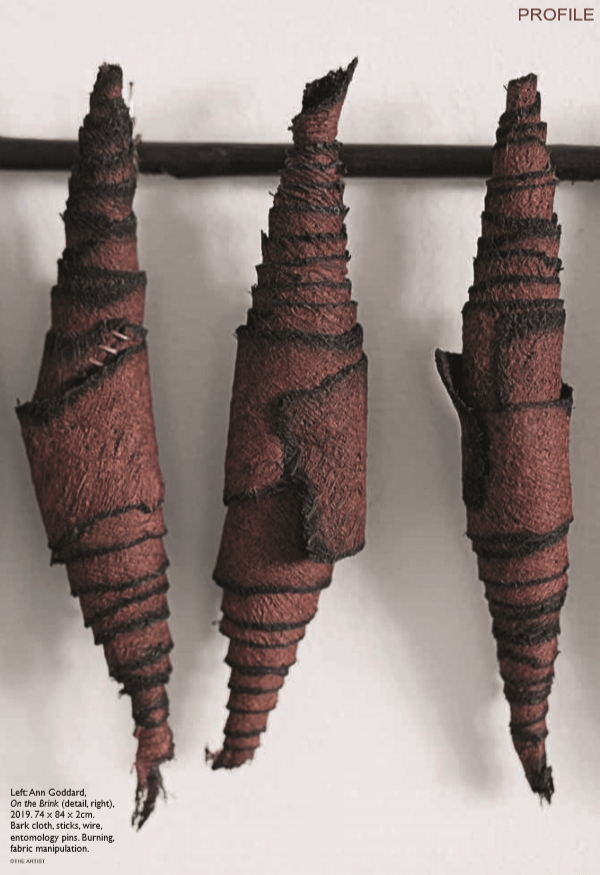
She began researching further, looking into butterflies in particular. ‘I made 40 of the forms black as if they’re shrivelling up and dying. I like to choose materials that make reference to the actual theme I’m exploring, and I chose barkcloth because it’s part of a living tree and makes reference to deforestation.’ Putting aside sketchbooks in favour of reading and visual research, Goddard often starts with language and phrases, from which she draws inspiration. She shows me a list that she’s collated, which relates to biodiversity – such as ‘changes in the landscape’ and ‘going up in smoke’. She has highlighted words such as ‘vestiges’, ‘relics’ and ‘remains’, and as well as starting points, they often provide titles for work. But, however exciting the cerebral connections, the real satisfaction comes in realising her ideas whilst working. It’s not always easy for artists to articulate why they make the work they do. For some that knowledge is communicated in the hand and through the making, and this has become Goddard’s strength, earning her plaudits along the way. Indeed, the road has been fortuitous but not without challenges. Before textiles, there was teaching. Originally from Middlesbrough, she taught in primary schools and during her training, had specialised in ceramics, ‘which probably explains why I’m more interested in three-dimensional things’. After moving to Cheshire and having children she was looking for a creative outlet that didn’t require a kiln. ‘I tried creative embroidery and joined a City & Guilds class. And it changed my life – it was fantastic.’ She praises her teachers Carole Whitehill and Maisie Hulmston, who taught her at Chester: ‘They were so inspirational and so supportive of my work – I can’t thank them enough.’
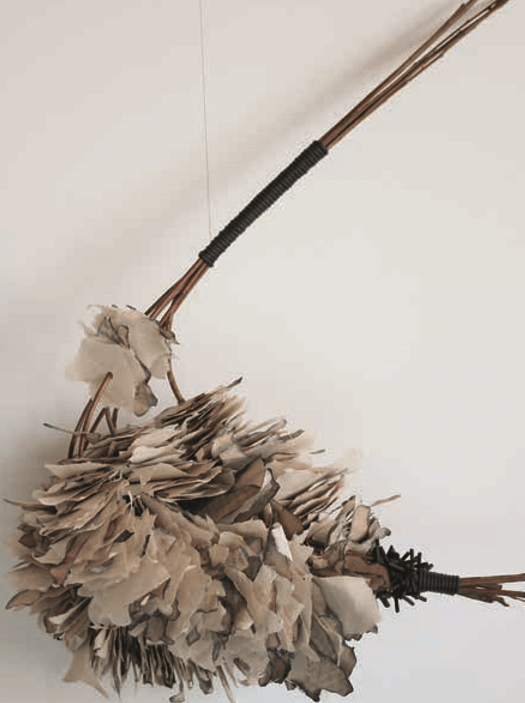
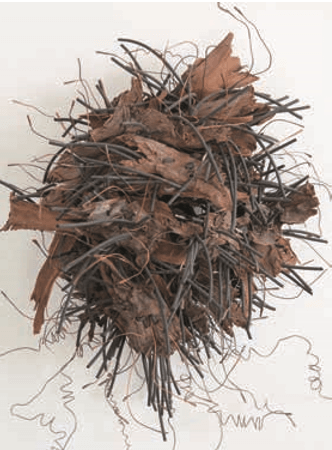
Left: Hanging by a Thread, (series, one of fie, 36 x 66 x 27cm approx. Willow, paper, neoprene cord. Tearing, burning, threading, wrapping, knotting. Above: Habitat (series, one of five) Ancient yew bark, neoprene cord, copper wire. Collecting, drilling, threading.
‘Whilst looking at the landscape, it seemed natural to look at the environment; how we’re encroaching on habitats.’
Under their guidance she was awarded a City & Guilds Medal of Excellence for Part 1 Creative Embroidery. Part 2 swiftly followed, plus a two-year HNC in Stitched & Constructed Textiles, which she completed in just one year, earning a distinction. ‘It was that course that got me interested in working with other materials. As well as doing embroidery, you were allowed to go into the other creative areas of the college, so I experimented with glass, metal, wood and print. I think the course was trying to get you to incorporate these materials into your embroidery… but instead I thought how can I introduce embroidery or sewing to these materials? By that stage, I realised I’m more a constructor – I like building things. That was the course that set me on the way I work now.’ A foundation year followed and the wins continued. Goddard was awarded a Charles Henry Foyle Trust Award for her piece Bristle (2000), which was fashioned from ceramics fastened to wood with machine-sewn textile cords. She used the money to enrol on a two-year MA in 2001 at Chester under Maxine Bristow. Whilst challenging at times, the experience allowed her to understand herself as a maker and confirmed her view that ‘the most exciting work being done now is in the craft world’. It was also when the natural world became her muse. ‘I started looking at boundaries because I realised I was working on the boundary of textiles, and that lead me to look at all sort of boundaries – in the landscape, between men and women’s work – what’s acceptable as fine art. Whilst looking at the landscape, it seemed natural to look at the environment; how we’re encroaching on habitats.’
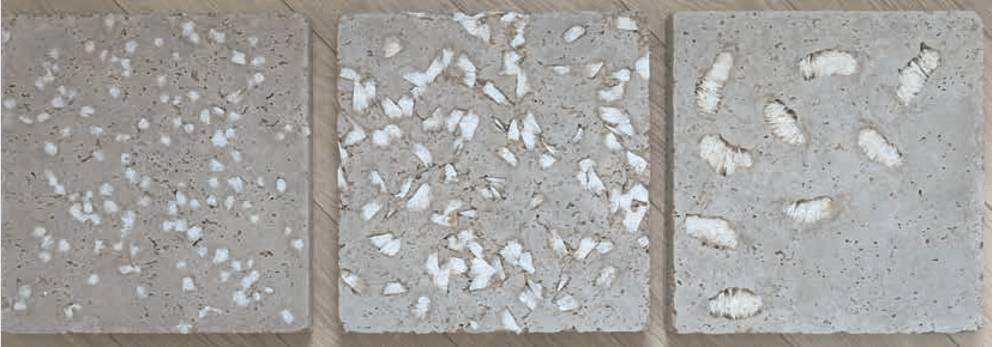
It’s the work she continues today in works such as Hostile Landscape (2015) – produced from one of her favourite mediums. ‘I do love concrete. It’s a series of nine hand-cast concrete slabs with forms embedded in it made from felted cotton paper, bristles and wire, meant to represent the natural world – small creatures, insects, seeds.’ The year she made it is also etched on her mind, as Goddard was dealing with breast cancer. Somehow she pressed on, producing this work – both monumental and affecting in its message. Currently this 62 Group member has been collaborating with Jae Maries and Shuna Rendel on a body of work they hope to tour soon. As for the future, Goddard says she has plenty of ideas still to explore. Her calling card has been a propensity for the kind of materials associated more with the construction industry than embroidery – rebar, concrete, metal, wire, bolts and rubber – witnessed in pieces like Limitations (2005), as well as found materials, driftwood, slate, glass and bark seen in works such as Habitat (2009). Her process is often one of sampling and exploring processes, such as burning. The former supports her preference for working in multiples (‘I tend to think I work better on a small scale, making larger works by combining multiple variations on the theme’), whilst the latter indulges a love of ‘using power tools’, as well as questioning the limitations placed on textile craft, which is traditionally viewed as ‘soft’. ‘I think that’s why I started combining textiles with materials like slate and wood as a way of subverting this traditional view.’ However it is her considered handling and economy with these materials that has made an impact, so much so that she now has £5,000 prize money to spend on making new work, and perhaps expanding her studio beyond her home’s garage. Whatever the future though, we will be watching what comes to pass in the hands of this unique maker.
